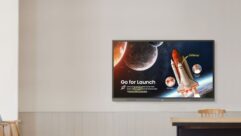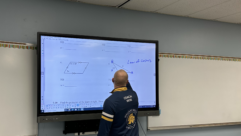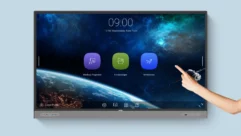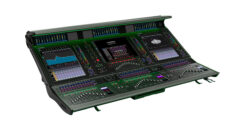
Favorite Tech Tools
Mar 1, 2006 12:00 PM,
By Bennett Liles
Don’t leave home without these pullers, fixers, and testers.
Leica Disto Lite5
The Neanderthal man had his fire and flints. From there, a series of simple gadgets from the wheel to the wireless remote have changed our lives by making new things possible or getting things done much more quickly and easily. After each of these advances, it has become difficult for us to imagine how we got along without.
In the AV age, there has evolved a group of gadgets enabling “AV Installer man” to ply his trade with the increasing speed and reliability required to ensure survival in the land of commercial sound and video system integration and installation. These widgets range from sophisticated, multi-function electronic tools to simple mechanical gizmos that extend human reach or manipulate physical objects. Now that convergence has erased the line between IP and AV, a new species of tools formerly confined to the computer technician’s realm have migrated over into AV tech territory.
Let’s take a quick look at some gadgets — both classics and newcomers — that deserve a hallowed place in the technician’s pickup-and-go box for IP, AV, and basic EZ.
First, my own entry is a gadget that has proved its worth dozens of times since I purchased it about a year ago.

Extron VTG-300
EXTRON VTG-300 TEST GENERATOR
In the realm of electronic Swiss Army knives for AV, the Extron VTG-300 and VTG-300R run among the leaders of the pack. Anyone who frequently responds to trouble calls involving sound systems and data projectors should have one of these handy. It is a ton easier and quicker than hauling a laptop computer around and hooking it up in a bunch of classrooms. Smaller than a cigarette carton, the handheld, battery-operated VTG-300 offers quick setup and storage of customized parameters and fast step-through of all available video patterns and audio tests. The small LCD screen provides the name and type of the parameter currently set and the level applied to the output.
Among the 10 video patterns available are H pattern; color bars including SMPTE, EBU, and eight-color split; 16-level split grayscale; crosshatch 32×24 and 32×18 for linearity measurements; white field for checking display uniformity; and multiburst and alternating pixels for resolution checks. A versatile selection of output rates includes RGBHV, component, composite and S-Video, and PAL and NTSC, as well as 4:3 and 16:9 aspect ratio formats. On the audio side there is pink noise, white noise, sine wave from 20Hz to 20kHz in 1/3-octave steps, swept sine wave, and audio cable polarity test waveform.
Handle-protected video connections include 15-pin HD, four-pin mini-DIN, and BNC, while a recessed panel on the bottom of the unit protects the XLR C3M, 1/8in. female mini, and RCA audio connectors.
The VTG-300 runs on four disposable AAs while the R version uses rechargeable batteries. Forget to turn it off? When running on batteries, the unit can be programmed to power down automatically after a selected time. An AC power adapter may also be used. Large rubber buttons and LEDs enable the user to quickly step through all the menus and output selections, and these are remembered after power-down. A rubber boot encases the back half of the chassis for protection. The MSRP is $995.
Don McCampbell of MMI Industries has several suggestions of handy helpers that he has used performing system installations for churches in the Atlanta area. Among these are the Gold Line polarity/phase analyzer, the TS-1A testset from Music Supply Company, and Push-Pull Rods by Cable Management Division of Assembly Electronics.

Gold Line APT2
GOLD LINE APT2/APT2B POLARITY/PHASE ANALYZER
The plethora of audio signal processing devices and connection patterns now available has introduced a somewhat tricky problem for installers of sound systems. As sound systems have evolved into more complex combinations of speakers and space, the task of ensuring correct acoustic phase and polarity has become more difficult and time-consuming. Gold Line has answered the call for this task with its APT2 and APT2B, instruments consisting of a pulse generator and a polarity/phase analyzer. Once the amplifier/speaker system is in place, the installer terminates the speaker lead to the speaker with a tip-positive 1/4in. connector and inserts this into a jack marked “speaker” on the pulse generator. A one-second 6.5V strobing pulse can then be heard from the speaker and is indicated for 300ms by an LED on the generator. Then, when the analyzer is held 2ft. to 3ft. in front of the speaker, it will indicate with a plus or minus whether the speaker cone is moving toward or away from the analyzer on each pulse.
The amplifier/speaker combination may be tested at once by connecting the pulse generator’s 0.4V output to the amplifier input via the pulse unit’s “line” XLR connector. The analyzer is then activated and held centered in front of each speaker to indicate the phase in the same way. In this way, the amplifier/speaker installation may be checked for consistency over multi-speaker arrangements. This pair of units enables the installer to check the whole system — including complete cabinets, equalizers, amplifiers, and crossovers — in minutes. The APT2 pair lists for $313.
MUSIC SUPPLY COMPANY TS-1A TESTSET
Combining versatility with extreme ruggedness, the TS-1A testset from Music Supply Company is a favorite tool of field installers for diagnosing problems on the run in situations where they may not have immediate access to an electronic scope or analyzer. The product enables the technician to detect problems in various devices by listening to the characteristic sounds they produce across the output.
Taking the form of a telephone handset with clip/leads, the unit may be used to check amplifier and phonograph cartridge outputs and mic/line inputs; quickly trace signals through a system; and check closed-circuit camera outputs, computer data lines, and power supplies by their sound. The test leads may be connected across a 600VDC power supply to detect ripple or placed across a 120VAC, 220VAC, or 440VAC power supply or a 500W amplifier.
The TS-1A can be dropped from the top of a 20ft. scaffold without breaking, and it is internally protected from electrical overload by solid-state limiting devices. Simplicity and reliability are the keys to this tool. It may be clipped right on the belt and carried for all these uses and more.

CMD Push-Pull Rods and accessories
CMD PUSH-PULL RODS AND ACCESSORIES
A helpful addition to the range of simple mechanical tools found in every AV system integrator and installer’s bag (wire strippers, crimpers, solder, etc.), is the Push-Pull Rods and Accessories Set. Anywhere cable has to be run beyond an arm’s reach is the domain of Push-Pull Rods. Cable Management Division of Assembly Electronics provides four 5ft., 1/4in.-diameter rods in each set, along with a variety of interchangeable tips. The polypropylene-coated, non-metallic fiberglass rods are flexible enough to go around corners and through bends in conduits. All rods are threaded at each end, so if your run is longer than 20ft. you can just add another set and keep going.
Among the screw-on tips available are the magnetic locator and the self-directional, V-shaped Grabit Hook with a serrated internal edge for collecting and holding loose wires. The bullet tip will make its way through tangles and has an eye for tying cables to it. The bullet tip can also be fitted with a metal loop for attaching larger objects. The pulling sock can handle up to 9/16in.-diameter bundles. This attachment can be fitted to rotate 360 degrees and is especially good for pulling fiber. CMD offers an entire line of such cable fishing, pulling, and poking devices. The Push-Pull Rods and Accessories Set lists for $84.
Bill Schuermann with HFP Acoustical Consultants also offers some suggestions of gadgets that have been very useful for him. HFP handles sound and video installations nationally from its offices in Calgary, Alberta, and Houston. Some of his favorites are the Whirlwind Qbox mic/line tester, the Leica Disto Lite5 laser meter, the Rat Sound Sniffer and Sender for phantom power checking, and the good old Shure A15TG battery-operated tone generator.
WHIRLWIND QBOX
One of several clever tools and testers from Whirlwind, this classic gizmo belongs in every sound tech’s toolbox. It provides a combination audio signal source/monitor amplifier; male and female XLR interfaces; and a 1/4in. line-in with a female, two-conductor jack that mutes the speaker when headphones or IFB earpieces are connected. A volume control adjusts speaker and headphone levels. The internal mic allows the Qbox to also be used for communication between techs at both ends of the line. A tone oscillator with output levels selectable at +4dBm, -20dBm, and -50dBm is included, along with colored LEDs for phantom power detection. A green LED indicates a positive 9V to 48V DC presence on XLR pin two, and a yellow LED monitors pin three. A red LED indicates internal power activation from the unit’s 9V internal battery. An external 9V power source may also be used; there is a handy schematic printed right on the top of the unit. The Qbox is available for less than $200.
LEICA GEOSYSTEMS DISTO LITE5 LASER METER
Before cable can be run and hardware can be correctly installed, accurate measurements must be taken, and these may necessarily be across places that are difficult or impossible to reach. For these situations, Leica Geosystems offers the Disto family of instruments using laser technology for quick and accurate distance measurement at the press of a button. The basic model, the Disto Lite5, offers a range of 0.7ft. to 650ft. with accuracy of 0.1in. With one-button selection for each function, the Disto Lite5 can provide up to 10,000 measurements on one set of AA batteries. Using the phase measurement principle, these instruments emit light pulses of a specific wavelength and pulse frequency. The reflection received is compared with one received internally and the resulting phase shift is translated into precise units of distance measurement. A range of carrying and adapter accessories is available for each of the Disto products. The Disto Lite5 lists for less than $400.

Rat Sound Sniffer and Sender
RAT SOUND SNIFFER AND SENDER
This little item provides a value far beyond its tiny size and price. The Sniffer and Sender form a pair of XLR cartridge-style devices for checking microphone lines and snakes, and they can indicate any problem that can cause mic trouble. When used alone, the Sniffer employs phantom power on the line to indicate shorts between pins, crossed conductors, or contact breaks. The combination of lit LEDs tells the whole story. When the Sniffer is used with the Sender on the other end of the line, a reverse between pins two and three can be read from the LED display. The 12V battery supplied with the Sender provides months of service and does not drain when the unit is on but not connected. It also will not harm mics or consoles if accidentally connected to them. The Sniffer alone lists for $24.95 and the Sniffer/Sender set costs $45.95.
SHURE A15TG TONE GENERATOR
I must second Bill Schermann’s nomination for this useful product and note a couple of similar cartridge-style tools in the Shure line. While very basic, they rate in the classic, must-have category for their utility and modest price. The size and shape of a stack of pennies, the A15TG uses an internal 1.5V camera battery to provide a 700Hz sine wave tone at 150V. This rugged item can not only operate for about 1,000 continuous hours on one battery, but can also tolerate phantom power and shorted lines. The only control provided is the recessed power switch. While primarily used for checking lines, the A15TG has also been connected directly to mic inputs on VTRs to provide color bar tones where router or mixer oscillators are not available. The product retails for around $90. Other great items in the Shure in-line group are the A15PRS switchable phase reverser, the A15AS mic attenuator, the A15BT bridging transformer, the A15HP high-pass filter, the A15LA line-to-mic pad, the A15RF RF filter, several impedance-matching transformers, and the A120S in-line switch.
Mike O’Rouke, president of Peachstate Audio and Lighting in Buford, Ga., has done AV installations all over the Southeast, and he recommends the TOA ZM-104 impedance meter and the Audio Control SA-3052 realtime spectrum analyzer.
TOA ZM-104 IMPEDANCE METER
The impedance of speaker lines can be affected by crossovers, attenuators, and a host of other elements currently available to customize sound systems for specific venues. This instrument is designed to provide an accurate reading of the impedance on those lines. Like our other entries, it is small, battery-operated, and rugged. Disconnect the speaker lead from the amplifier output, connect it across the leads of the ZM-104, and you have your collective impedance figure in a range of 5V to 100,000V. Four AA batteries will supply 30 continuous hours of operation. Its weight including batteries is only a couple of pounds. Using the zeroing button, the operator shorts the leads and then uses the setting knob to calibrate the display at zero. With the TOA ZM-104 you know exactly what your amp outputs are seeing, and can test transformers, check continuity, and identify wire pairs. The unit retails for around $300.

Audio Control SA-3052
AUDIO CONTROL SA-3052 ACOUSTIC SPECTRUM ANALYZER
For fine-tuning the acoustic response of any venue, the SA-3052 is the tool of choice. Its features include a pink noise generator, calibrated microphone, six non-volatile memories plus averaging, digital SPL display, peak hold utilities, and weighting filter in an all-metal, battery-powered mobile unit. The unit is up and running in three seconds. The display shows 30 bands from 25Hz to 20kHz and broadband SPL. A gel-cell battery can keep the analyzer going for about four hours and begins recharging whenever this tool is connected to an AC source. For hard-copy printouts, there is a parallel printer port. The SA-3052 is available for just less than $1,000.
The convergence of IP and AV has made digital transmission quite common and added Cat-5 cable, RJ-45 connectors, and fiber-optic technology to sound and video installs everywhere. With these have come some of the computer network tech’s tools of the trade.
TEST-UM RESI-TESTER
A very useful tool for dealing with the widening variety of cables and signals with which AV field techs must work is the Resi-Tester from Test-Um. This 9V battery-powered unit features testing and tracing for coax, network (eight-wire), and telephone (six-wire) cable by using an internal tone generator and a detachable remote unit. Also available is an accessory kit containing 20 numbered wire-mapping remotes for checking multiple lines at one time. The RJ-45 and RJ-11 remote sets of 20 are less than $25 each. The Resi-Tester checks for shorts, miswires, reversals, and split pairs. Test results are displayed in wire map format on a large, seven-segment LCD. The tone signal may be assigned to any cable connector on the unit and to any pin on each connector. In order to speed testing, the unit will remember the setting. The versatile Resi-Tester retails for less than $100.
CHANGING TASKS, CHANGING TOOLS
As the world of sound and video installation evolves, the tools used to run a widening array of cable types, test these lines, and locate resources are also changing. A reflection of this trend is the increasingly diverse range of functions, connectors, and operational modes to be found on the latest gadgets and on the most popular classic tools in the AV tech’s grab-it-and-go box.










